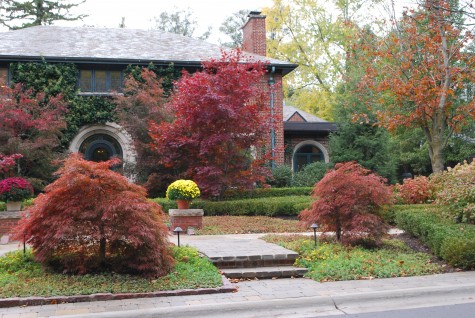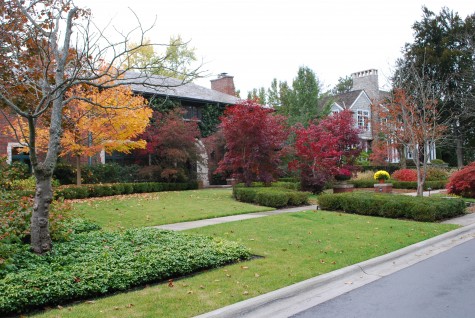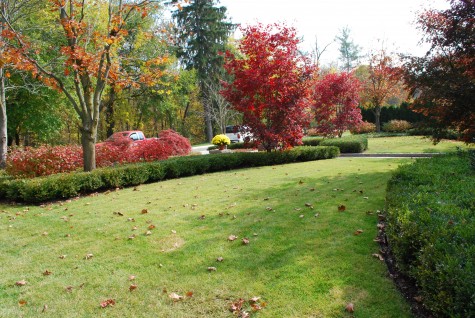 Some time ago I voiced the opinion that I was not a big fan of Japanese maples. I heard back about that in spades. So yes, I will concede that they are beautiful trees with enchanting habit and great bark and leaf color. But they can be very tough to place beautifully in a landscape. The red leaved varieties are striking in appearance. The flip side of striking? Visually demanding. A specimen tree is just this-a stand alone special element around which an entire space may be organized.
Some time ago I voiced the opinion that I was not a big fan of Japanese maples. I heard back about that in spades. So yes, I will concede that they are beautiful trees with enchanting habit and great bark and leaf color. But they can be very tough to place beautifully in a landscape. The red leaved varieties are striking in appearance. The flip side of striking? Visually demanding. A specimen tree is just this-a stand alone special element around which an entire space may be organized.
 A beautiful specimen tree asks for a placement that reinforces this idea. If the idea is to feature a particular plant, other elements in the landscape need to take a supporting role. Of course landscapes can be organized around a series of spaces or rooms, each with their own diva. In my own landscape, my trees are either hedged, or planted in drifts, as the divas of my landscape are ornaments. A fountain pool and groups of pots are focal points. This is by no means the best way to design a landscape. This is merely what I like.
A beautiful specimen tree asks for a placement that reinforces this idea. If the idea is to feature a particular plant, other elements in the landscape need to take a supporting role. Of course landscapes can be organized around a series of spaces or rooms, each with their own diva. In my own landscape, my trees are either hedged, or planted in drifts, as the divas of my landscape are ornaments. A fountain pool and groups of pots are focal points. This is by no means the best way to design a landscape. This is merely what I like.
 This front yard landscape was home to 9 Japanese maples, representing 5 different cultivars. When I first saw it last October, some of the maples had black-red leaves. Some had brown-red leaves. Others were more clearly red. In addition, there was a lovely sugar maple, showing yellow fall color in this picture, and 5 additional shade trees. This made for 15 trees total in the front yard. Some trees were in poor condition.
This front yard landscape was home to 9 Japanese maples, representing 5 different cultivars. When I first saw it last October, some of the maples had black-red leaves. Some had brown-red leaves. Others were more clearly red. In addition, there was a lovely sugar maple, showing yellow fall color in this picture, and 5 additional shade trees. This made for 15 trees total in the front yard. Some trees were in poor condition.
 Landscapes in urban neighborhoods are tough to design. They require a judicious hand, and a willingness to edit. Every landscape gesture needs to be informed by that scarcity of space. A landscape also needs to work in close concert with that dominant element-the home. A landscape that respects the architecture will read coherently. There are many voices here struggling to be heard.
Landscapes in urban neighborhoods are tough to design. They require a judicious hand, and a willingness to edit. Every landscape gesture needs to be informed by that scarcity of space. A landscape also needs to work in close concert with that dominant element-the home. A landscape that respects the architecture will read coherently. There are many voices here struggling to be heard.
 Of course it is easier to see years later how a placement of trees might be wanting. Hindsight is 20-20. Imagining the space a tree will occupy at maturity is an art; the best practioner I knew is this regard was Al Goldner. He fearlessly placed trees in anticipation of what they might become 20 years later-even if the landscape looked too sparse and almost undone to begin with.
Of course it is easier to see years later how a placement of trees might be wanting. Hindsight is 20-20. Imagining the space a tree will occupy at maturity is an art; the best practioner I knew is this regard was Al Goldner. He fearlessly placed trees in anticipation of what they might become 20 years later-even if the landscape looked too sparse and almost undone to begin with.
 Trees planted very close to the foundation of the house may be lovely the day they go in. Years later, they can obstruct any view of the architecture they meant originally to celebrate. It is equally as important to consider the views out from within as it is those views from the street. Several rooms inside are dark, as the windows are covered by branches of the trees. These branches are equally obstructing the views out into the landscape.
Trees planted very close to the foundation of the house may be lovely the day they go in. Years later, they can obstruct any view of the architecture they meant originally to celebrate. It is equally as important to consider the views out from within as it is those views from the street. Several rooms inside are dark, as the windows are covered by branches of the trees. These branches are equally obstructing the views out into the landscape.
 Every landscape has a foreground, a mid ground, and a background space. Those spaces need to work, no matter the angle of the view. The Japanese maples might have presented a completely different appearance, had they been pruned differently. Each had foliage to the ground. They read visually as giant red shrubs, not small trees with interesting branching, and an airy appearance. Maintenance is a very important part of a landscape.
Every landscape has a foreground, a mid ground, and a background space. Those spaces need to work, no matter the angle of the view. The Japanese maples might have presented a completely different appearance, had they been pruned differently. Each had foliage to the ground. They read visually as giant red shrubs, not small trees with interesting branching, and an airy appearance. Maintenance is a very important part of a landscape.
 Once the trees were gone, other elements emerged. A pair of hollies on either side of the front door grew at different rates, and generally suffered from trees planted over them. The boxwood had declined as well. They have damage from leaf miners; perhaps they were pruned too late in the fall. There is some work ahead restoring them to good health.
Once the trees were gone, other elements emerged. A pair of hollies on either side of the front door grew at different rates, and generally suffered from trees planted over them. The boxwood had declined as well. They have damage from leaf miners; perhaps they were pruned too late in the fall. There is some work ahead restoring them to good health.

The beautiful sugar maple, and the hemlocks flanking each end of the house are appropriate and friendly to the architecture. We moved a lot of plants yesterday. Viburnums, azaleas, hollies, oak leaf hydrangeas, limelight hydrangeas, boxwood and fothergilla. The renovation of this landscape is underway.